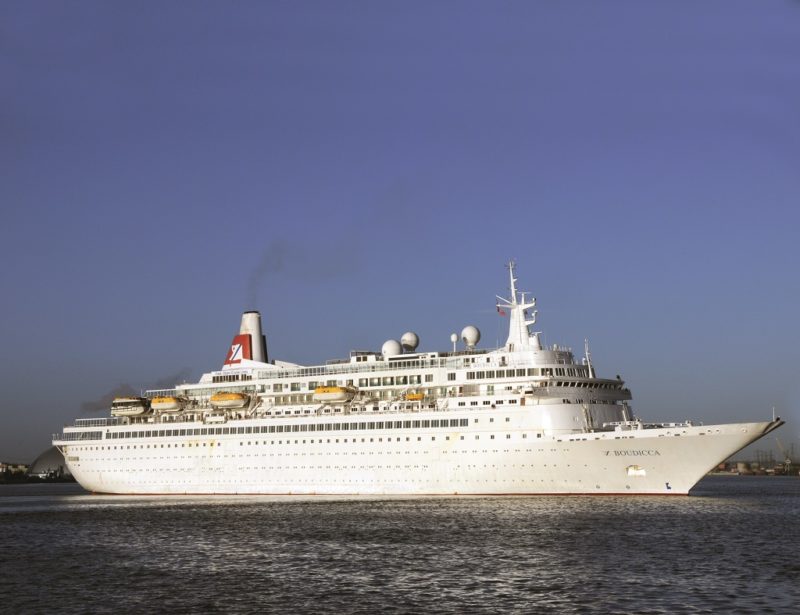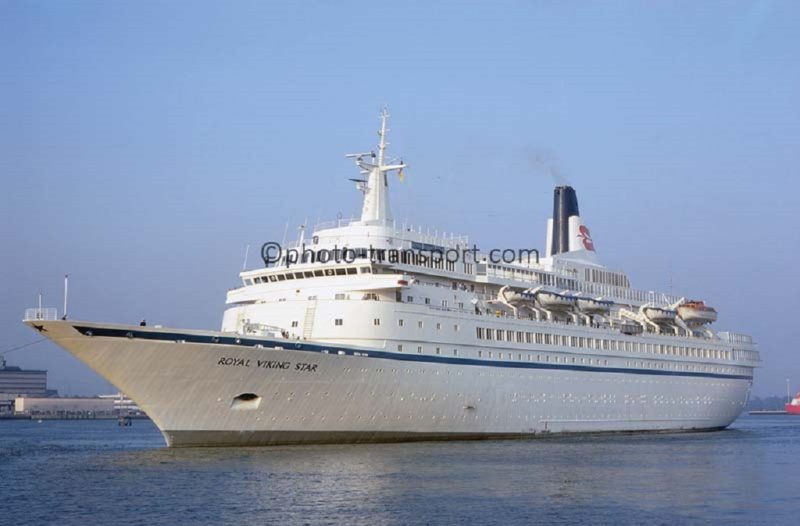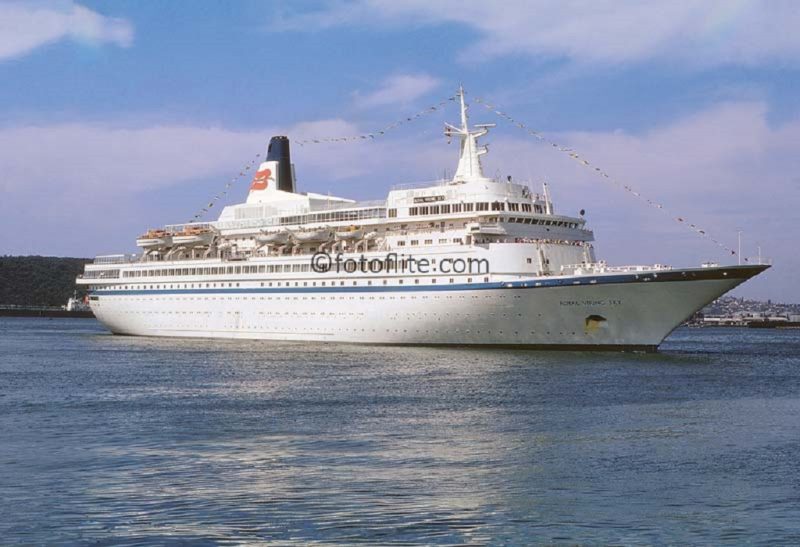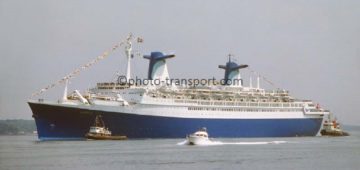Royal Viking Sea, Royal Viking Star and Royal Viking Sky

Although ordered fifty years ago, this trio of five star luxury purpose built cruise ships kept their deserved place in the crowded world of new and bigger cruise ships until recently. The trio were products of the early 1970s from the O/Y Wartsila yard at Helsinki, builders of many famous cruise ships. They were completed for the new Royal Viking Line, one of five new cruise companies at this time, the others being Carnival Cruises, Royal Caribbean Cruise Line (RCCL), Princess Cruises and Norwegian Cruise Line (NCL). Royal Viking Line had been set up jointly in 1970 by three Norwegian shipping companies, Bergen Line, a well known ferry and passenger ship owner with much cruising experience, Nordenfjeldske of Trondheim, well known on the Hurtigruten service to the North Cape of Norway from Bergen, and A.F. Klaveness of Lysaker (Oslo), a well-known tanker and cargo ship owner since 1898.
The three companies each ordered a twin screw cruise ship of 21,850 grt from the Wartsila yard in Helsinki at a cost of $22.5 million each, and they were completed as Royal Viking Star in June 1972 (the Bergen Line ship), Royal Viking Sky in June 1973 (the Nordenfjeldske ship), and Royal Viking Sea in November 1973 (the Klaveness ship). A.F. Klaveness withdrew from the consortium in 1975, leaving Royal Viking Sea jointly owned by Bergen Line and Nordenfjeldske until both sold out to the Kloster family in 1984. Royal Viking Line had Warren Titus, with previous cruising experience at American President Lines and P&O, as Company President and Marketing Director at their San Francisco headquarters.
However, the influence of Warren Titus extended beyond this into every aspect of shipboard design and décor, which became a standard for cruising good taste. As a consequence, the three worldwide cruise ships built up a good repeat business especially with their older customers, who liked the high standard of service. The brand offered continual new and imaginative destinations in a comprehensive cruise atlas or brochure, including Round the World cruises of over 100 days duration from New York, Alaskan cruises from Vancouver, short New England and St. Lawrence cruises from New York, Caribbean and South American cruises from Miami, Mediterranean and Black Sea cruises from Venice and Piraeus, Baltic and North Cape cruises from Copenhagen, and Round Britain cruises from Southampton.
As completed, they had sharply raked bows with excellent open deck Boat Decks for sun bathing and exercise, and their tall funnels consisted of three sections with the engine exhaust pipes in the taller central section, and the red Royal Viking ‘lyre’ logo on the white casing of the outer sections. They had accommodation for only 539 passengers in cabins located on eight passenger decks, named as Sun, Sky, Promenade, Scandinavia, Atlantic, Pacific, Mediterranean and Sauna decks. There were also 32 de-luxe three berth cabins consisting of a bedroom, sitting room and bathroom, and all passengers enjoyed the public rooms of the Dining Room, Main Lounge, Observation Lounge above the bridge with excellent views, Sky Bar, Night Club and Lido Bar. The ships were air conditioned throughout, and there was an outdoor pool, gymnasium, sauna, a double height theatre extending over two decks, library, gift shop, beauty salon and barber shop. Royal Viking Sea, the Klaveness ship, was the last to be completed and arrived in the Tyne on 25th November 1973 to embark passengers on her maiden voyage on the Tyne to Bergen route, temporarily replacing Leda during her overhaul.


This voyage was a North Sea ‘shakedown’ voyage to test her facilities and her new crew. Royal Viking Star differed from her two sisters in that she was two feet shorter in length and featured a chapel just forward of the theatre, which was not included in her two sisters, and there were minor differences in the lounges and library. She then began her long career of top of the range luxury cruises, which were later published by Royal Viking Line in book form as ‘Voyages of the Royal Vikings’, a coffee table book of beautiful colour photographs grouped according to geographic cruise areas. The Royal Viking Line brochure was packed with lengthy and diverse cruises, and gained the nickname of ‘The Atlas’. Royal Viking Sky and Royal Viking Star became the first sister ships to transit the Panama Canal simultaneously in the opposite directions on 1st May 1976, the Sky sailing westwards and the Star eastwards.
The trio were lengthened by a 93 feet long prefabricated ‘midships section at the A.G. Weser yard at Bremerhaven during 1981/82/83 during a three month refit in an effort to attract more younger customers by raising capacity from 550 to 750 passengers. The mid-section that was inserted mainly consisted of cabins, but aft of the Observation Lounge a new lounge and nine penthouse suites with balconies were added and were named after destinations. The size of the Dining Room was also doubled and now occupied nearly one half of one deck in order to maintain single seating dining. The trio were now of 28,220 gt and in my opinion, were even more handsome than when built, the longer passenger accommodation being balanced by their highly raked bows and tall, elegant funnels. This lengthening was a big gamble by Chief Executive Torstein Hagen, as the Royal Viking Line mainly depended on repeat business, a gamble that didn’t pay off.
Their valued repeat business was gradually eroded as many loyal passengers felt that the trio had lost their intimate appeal, and had lost out to the many new cruise ships that entered service during the 1980s. A new generation of small five star luxury cruise ships such as the ‘Sea Goddesses’ and similar ‘super yachts’ stole many of their discerning cruise clientele.

On 29th November 1983, Royal Viking Sea rescued 151 survivors from the Indian ferry Dojo, who had been adrift for eleven days in the Celebes Sea. However, Royal Viking Sky suffered a very bad fire during a cruise and arrived at Bremerhaven for repairs on 18th May 1984. As a result, the cash flow situation deteriorated alarmingly, and Bergen Line and Nordenfjeldske sold the trio during that month to Kloster’s NCL (Norwegian Caribbean Line) for around $250 million, with Warren Titus leaving the company during the following year.
Subscribe today to read the full article!
Simply click below to subscribe and not only read the full article instantly, but gain unparalleled access to the specialist magazine for shipping enthusiasts.






Comments
Sorry, comments are closed for this item